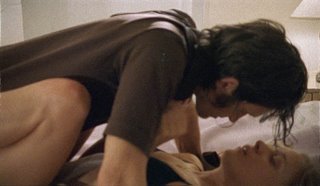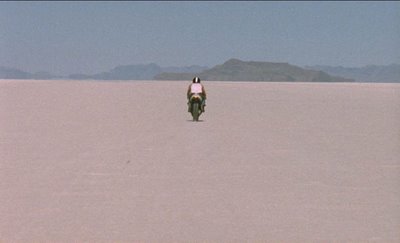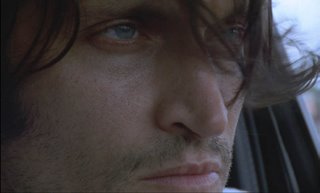
Ridiculed as the worst film in Cannes history, this offering from Vincent Gallo is renowned for its controversy. Not only for its framing as a misogynistic expedition into the ego of its Actor/Writer/Producer/Cinematographer/Camera Operator/Make-Up Artist/Caster/Artistic Producer/Set Designer/Editor and Director where no woman can resist his charms but also its 10 minute oral sex scene finale.
Now this film has been shackled by its reputation, not only for these reasons but it seems that Brown Bunny has waded through a quagmire of controversy and media ridicule. Can it ever stand in its own right as a beautifully poetic portrayal of a broken man with its most famous scene as an opening sentence to its poignant final paragraph used to twist the plot and raise it to an anti-road movie that contains a subdued momentum lacking in many of its peers.
Gallo has never shied away from his reputation and fuels his media coverage by stunts in one of the most bizarre attempts ever by a lesser movie celebrity to capitalize on his fame, Gallo offered to sell his semen for $1 million including "all costs related to attempt an invitro fertilization". Fertilization by Gallo "the old fashioned way" will cost $1.5 million. Gallo says that his offer is not open to "those of extremely dark complexions" and offers a $50,000 discount to any woman who is blonde, blue-eyed, or related to "any of the German soldiers of the mid-century." Gallo is also known for his unashamed attacks in the media that hit a peak when he wished that Roger Elbert, (the critic that helped to sink brown bunny for his claims of it being the worst film in Cannes history) would develop cancer, Elbert was subsequently diagnosed with thyroid cancer.

Gallo’s outspoken media persona and audacity as an auteur always wishing to kick up a fuss seem to be the final nails in the publicity coffin of Brown Bunny. His personal attacks on Elbert, calling him a “fat pig” in the press and Elbert retort that “I can loose weight but your film will always be a flop” and the media coverage of Chloe Sevigny being dropped by her agency, alongside its Gallo firing Kirsten Dunst as the lead role (supposedly) although Dunst Claims she walked out on the day of filming as the shoot didn’t comply with SAG guidelines all this and more has tainted many viewers perception of this movie.
Was Elbert right, will this film always be a flop? With the controversy fading over the years and Brown Bunny fading in the collective media mind as a film that should always be remembered for its tabooed finale, Brown Bunny can be re-framed as a cinematic offering that is both militant in it’s anti-commercialism and as a slow and winding portrait of a man worn down and broken beyond repair by guilt and lost love. This film like others in this season is anchored by its twist, the film relies on its final paragraph as so much of contemporary cinema does, leaving you in the final moments of the film with the heavy weight of loss.
Its opening shots of a motorbike race (on its first cut lasting a gruelling 20 minutes) are a perfect condescend metaphor to summarise the slow plot, a road movie with a circular track, where Gallo can never triumph, (after all Bud is never depicted as a good motorbike racer, and the viewer is left to imagine that in every race bud is left a looser). He looses the race and embarks on his road trip across America to his next race. Gallo’s first cut although unconventional would draw attention to the importance of this scene and work as a tool to highlight the often overlooked repetition and cycle in the narrative.

Its loitering grainy camera work in 16mm, it’s off kilter framings, lingering out of focus shots, powerful score and its sombre low tempo dialogue make a haunting portal of a man lost without love. As Gallo dashes the hopes of this female road trip companions and visits his past in an attempt to regain his love, every woman becomes one woman, Daisy. As Bud (Gallo) fills the void that has manifested through guilt with brief (non sexual) encounters with fleeting women, prostitutes and fast bikes a repetitive cycle unfolds that is left open to repeat its self, Brown Bunny is a portrait of desperation and solitude. In a tradition of road movies the characters emotional revelations are left till the final moments of the film, but with an open end, that is fast becoming a tradition in anti-road movies, this harrowing ending is a climax that contextualises the films meandering slow plot (one that so many people walked out on before seeing).
Shot with an average length of 18 seconds per scene compared with its American Cinema average of 2 to 5 seconds to ponder a shot, this deliberately slow paced, contemplative piece of cinema documents the mundane with a sharp eye. A seemly circular narrative shows that the pace of the movie is integral to its plot, and cements it as a perfect example of the new/anti-road movies.
Gallo’s slow pondering film, slowly constructs a seemingly continuous narrative of misogyny that unfolds to reveal its lead trapped with a cyclical and continuously repeating series of brief encounters, which at first seem to me to be a choice but as the film ends are revealed to be a pit of despair. Gallo/Buds life has become an ever closing tomb, a monument to lost love with seemly no escape.

Labels: Alan Hook, American Cinema, Chloe Sevigny, Road Movie, Vincent Gallo




